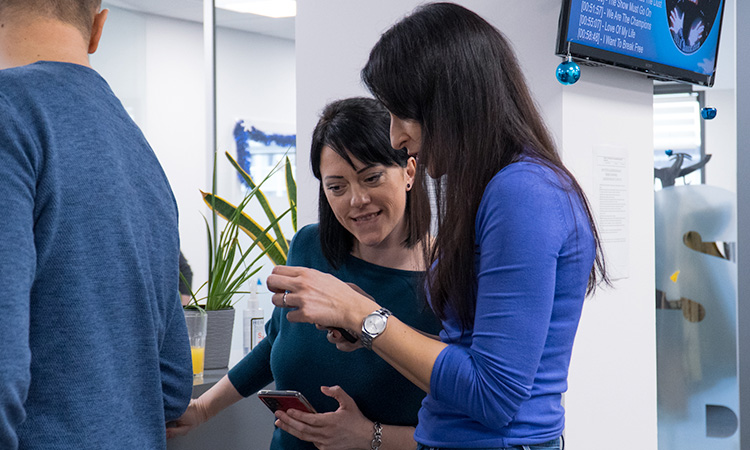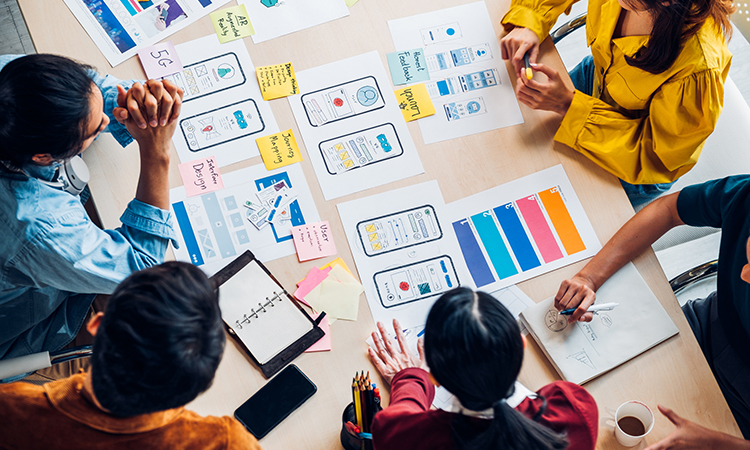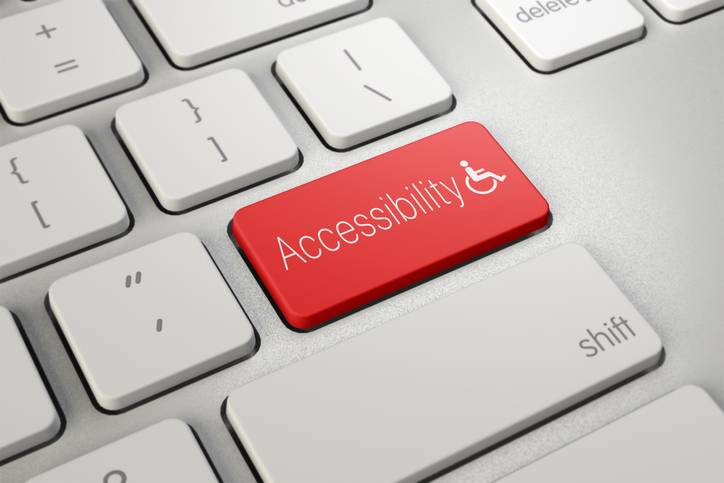Except for amateur programming enthusiasts, rare are the people who build a mobile app alone and then expect significant business success.
It’s more common that someone gets an idea for a new app and then looks for the right custom software development partner.
This article goes through the major stages of building a mobile app from scratch and proves how BrightMarbles Group can help you get your app up and running.
Ideation and Research

As a new idea for a mobile app comes to your mind – the valuable one, not that pretentious concept you ditch at first sight – it’s time to do some research and see who would go for this solution.
At this point, your goal is to learn as much as possible about the market itself. For if you don’t know who your mobile app is aimed at, it won’t bring the conversion you want, no matter how good the engineering team is.
Let’s go through the main steps you need to take before the app requirements have been specified:
- Target audience identification. Find out if many people experience the problem(s) that your tool would solve. Mind the demographics, tech preferences, behavioral patterns, and existing pain points, as well. For example, if you want to build an app with recipes for family meals, it’s clear your user persona won’t be a student gamer in their 20s, but an employed person above the age of 25. On the other hand, the target audience data also guides developers and designers in creating personalized and relevant app experiences for their intended audience. For instance, an app aimed at young professionals might prioritize efficiency and integration with other productivity tools, while an app targeting retirees might focus on ease of use and accessibility features.
- Competitive landscape. This is a business-analyzing technique that helps organizations identify their competitors. Learning which similar businesses and their belonging apps are your rivals, how they interact with one another, and what major business challenges they face will give you more info on how to follow suit with your app.
- Competitor analysis. In addition to the competitive landscape, you’ll need to conduct a competitor analysis. During this market-research stage, you’ll collect vertical in-depth information about your major competitors. In this case, it means studying their relative mobile apps, what key features and functionalities they contain and obtaining data about the reception of their respective mobile apps on the market. Obligatory: check out their reviews on mobile app platforms (Google Play and App Store) to identify the weak points and offer solutions in your app.
- Conducting surveys. Surveys will let you feel the pulse of the market firsthand. Within the market research stage, share purpose-made surveys via social channels, starting from LinkedIn and Facebook, spreading to Quora, Reddit, and other relevant opinion-sharing and -collecting websites. Send out these purpose-made questionnaires to relevant email addresses from your list to see whether people would use your potential app with its functionalities.
- In-Depth Analysis of User Interactions and Preferences. At the core of developing a successful mobile app lies a profound understanding of user behavior. This involves diving deep into how potential users interact with similar apps, their preferences, and the challenges they face. By employing tools like Google Analytics and user session recordings, developers gain valuable insights that directly shape app feature design.
BM Insight: We have an in-house team of experienced marketers. From market research and comprehensive marketing campaigns to videography and content/copywriting, we provide a full-scale digital experience. Our Chief Experience Officer Nevena Nemeš talks about it in her extensive guide Empowering Brands through Full-Spectrum Digital Services.
Planning and Estimating

Planning is extremely important for all the interested parties in a mobile-app-development process: the client(s), the engineering team, the company management, and the investors.
The key function of a project plan is to evaluate the necessary mobile app features and resources, as well as to arrange the approximate milestones and schedules.
As for the estimation, the development team determines the expenses and benefits. They depend on the number of software engineers working on the project, which is, in turn, influenced by the technology used for that project and the client’s requests.
Adequate and timely planning and estimating brings the following benefits:
- Risk mitigation. The risks of missed deadlines, exceeded budgets, and defective final products are significantly reduced.
- Building trust. If a client can choose between a softdev provider that submits a full-fledged project plan and estimation, and one that isn’t that detailed, guess which one they’ll opt for.
- Reducing arbitrariness. Paying for any service includes a certain level of expectancy. Timely and broad planning buys a client’s peace of mind and reduces arbitrary solutions.
- Communication pathways. A detailed mobile app development plan makes communication with clients less stressful and generally easier.
That said, it’s important to know that development plans and estimates aren’t set in stone. They should be considered approximations and reference points for all the stakeholders included.
If planning and estimating are carried out in detail, by experienced project managers and engineers, the risk of creating a defective product is significantly mitigated.
As for pricing, everything must be negotiated in advance, to avoid misunderstandings during the later stages of app development. To learn more about this topic, read our article Beyond the Quote: The Realities of App Development Pricing, by Svetlana Kosić.
BM Insight: Mobile app development is not a linear process; at least not if done through the Agile development methodology. At BrightMarbles Group Holding, we embrace and apply this methodology, including its most widely used framework Scrum. We do everything by the book, from sprints and continuous iterations to regular ongoing feedback and improvements throughout the entire development procedure.
App Requirements and Expectations

Before the designers draw the first line of the wireframe, it’s necessary to create a document with clear app requirements, specifics, and expectations.
Based on the app conceiver’s idea, conducted market research, planning and estimating, all the main milestones need to be weaved together into a cohesive unit.
Here are the main sections that the document with app requirements and expectations should cover:
- Business benefits. Sum up why this app has a potential (from the research materials gathered earlier), who it will use, how it will be monetized.
- Operational orientation. Include the deadlines, milestones, and estimated costs.
- Developmental factors. List the tech stack necessary to build the mobile app in question, from the app type (native, cross-platform) to front-end and back-end technologies and programming languages.
- Design features. List the major user-experience features, from navigation and button distribution to mutual functionality of separate sections and screens.
Designing the App with Users at the Center
As our design maverick Marko Vladušić says in his article UX Design: The Binding Tissue Between People and Technology, user-experience is a process of sculpting digital products, applications, and services from a user’s point of view. Those solutions need to be functional, intuitive, and enjoyable for users.
The designer’s approach must include understanding user behavior, needs, and preferences.
As mentioned above, during the software development lifecycle, the stakeholders need to decide as early as possible whether an idea has practical use. In other words, the person who has ideated the app usually sits down with the designers and engineers that would develop it. The aim is to check out with the tech pros whether the imagined product can be built in the first place.
This is where the proof of concept (PoC) saves the day. Even if the client has done the market research above on their own and concluded it might work (which is not what we suggest), they don’t possess the technical background to bring the final verdict.
But when the idea has been confirmed by the tech stack, the designers and engineers can move on and start working on the prototype and minimum viable product (MVP).
Core Design Work
When a designer faces the new app development process, they usually begin creating wireframes to sketch the app’s layout and specify where each button would go. The designer and the app creator can work together on the sections that the app needs to contain. A UX-optimized mobile app is a must for every business, but it’s even more important for a newly founded startup. Our product designer Mladen Maksimović explains that smooth design is a deal breaker, in his guide Importance of User Experience Design for Early-Stage Startups.
Once the initial layout has been finalized, it’s time for the first interactive prototype. At this point, the designer(s) should see how smooth the user flow is. The app owner can but doesn’t have to participate in this part.
Accessible and Inclusive Mobile Apps

Modern apps should be made with different categories of users in mind. This especially refers to people with some sorts of physical disabilities and therefore have limited access to mobile app usability.
BMGH follows the Web Content Accessibility Guidelines 2.1 (WCAG) wherever possible in software development projects.
From practical accessibility features, such as web pages optimized for screen readers, to motor skills accessibility, we have embraced the digital equality policy, determined to advocate it in all our projects.
Mobile App Development and Tech Stack
Before the core programming works begin, engineers and project managers need to choose the right tech stack for the mobile app in question. Basically, it includes all the software tools, programming languages, and frameworks necessary to develop and test a mobile app.
For mobile app development, the common tech stack consists of the front-end framework, back-end server, operating system, and corresponding database.
A properly selected tech stack with mutually complementary features results in enhanced app’s performance and user-centered functionality.
Depending on the operating system the app will work in, there are three possible development environments.
Native App Development
Let’s first cover the native app development. It refers to building mobile applications made particularly for a specific operating system, i.e., either Android or iOS. The main advantages of this development type are endless customization options for numerous functionalities and user-centric features. Logically, it typically costs more than cross-platform mobile apps.
Tech Base for iOS Apps
Apple Xcode is the main development toolkit for iOS apps. It contains numerous tools and options which make building, deploying, and testing iOS apps.
Objective-C is the most widely used front-end programming language for developing iOS apps. In the last couple of years, Swift has also risen to become a more intuitive and modern alternative.
The iOS software development kit (iOS SDK) is a catch-all solution that comprises everything you need to develop iOS apps, from UI elements to data storage libraries and proper networking.
Finally, the UIKit gives developers various user interface – hence UI – features and solutions for creating iOS apps. It comes with ready-made details, such as tables, labels, and buttons.
Android App Set

The Android Studio tech stack is an open-source tool for building mobile apps with ready-made elements, like swift emulator, visual editor, smart code editor, a debugger and other handy tools for building and testing Android apps.
The Android software development kit (Android SDK) comes with numerous elements for building Android apps, from valuable libraries and code samples to diverse documentation.
Android framework is a group of APIs that contains useful classes, such as view management and event handling.
Java is the most commonly used, object-oriented programming language for developing Android apps.
Kotlin is a newer programming language also aimed at developing native Android apps. Its simplicity and neatness have attracted many engineers to use it for mobile app development recently. Google has also opted for Kotlin as their preferred programming language, compatible with Android Studio.
Cross-Platform Mobile App Development
If the client opts for a cross-platform model, it means developing two apps for different platforms with one codebase, most commonly using Flutter, React Native, or Xamarin. Even though each of the app iterations will be compatible with its relevant operating system (iOS or Android), such apps might lack certain features, in comparison with native apps. This is also something that the app conceiver and the tech stack need to discuss in advance.
BM Insight: In terms of app development, our engineers are here to explain the pros and cons of each app-development route. Our app specialists have worked in both environments, and they know what each of these worlds offers to clients and users of their apps. Our Marko Krstanović, who has participated in several large projects, explains the benefits of hybrid app development model through Flutter in his article Flutter: The Future of Cross-Platform Mobile App Development.
Mobile App Security

Ensuring that in-app and user data are secure is the backbone of well-made mobile app. Otherwise, all the successfully implemented steps described in this guide will be in vain.
Let’s cover the main security measures for building a shielded mobile app.
- Code security. The code we write, and the code written by out-of-house teams are always protected in line with the most stringent information-securing information. The ISO 27001 Certification that BMGH earned in 2022 proves our dedication to client and business data protection.
- Sheltered communication. Every mobile app must be built in line with secure communication principles. Users must know that everything communicated between them and the business behind the app remains confidential (chat, email messages, push notifications, etc.)
- Safe data storage. Many mobile app owners face security challenges when it comes to storing customer payment data. A rule of thumb is that credit card information is kept only as long as it is necessary to complete the transaction. The user’s personally identifiable information (PII) can be stored if they stay logged in. Find out more about user trust and digital payments in a blog post written by Milena Petrović.
- Multifactor authentication. In a nutshell: clients who want to increase their customer data security need to ask their software provider to implement multi-factor authentication in their mobile apps (especially in eCommerce).
- Strong data encryption. The user data transferred within the app and between the app and the server/cloud must be encrypted. It prevents data interception and theft while boosting the overall app and user security.
BM Insight: Software development companies and their clients alike need to adhere to data-protection laws. For the EU-area, the umbrella legislation is the General Data Protection Regulation (GDPR); its US counterpart is the California Consumer Privacy Act (CCPA). These regulations prescribe transparent management of consumer data and app store features. Mobile app functionalities and in-app content should rely on these regulations, so that the app is fully compliant with the required standards. Engineers must apply the necessary regulations during the app development process, to build user trust and avoid any potential legal roadblocks. When building apps for specific markets, getting familiar with the relevant applicable laws is a must, as well.
Why Testing Is Vital Before the Launch

We’ve extracted testing outside the typical order in mobile app development – logically speaking, it would come after the development stage – to emphasize its close relationship with the touchpoints above.
When a mobile app is being built, its functionalities and desired features must be tested already at early stages. Waiting until all the icons or screens have been finished usually results in longer development, which might cause turmoil in our partnerships with clients. As everybody is keen on maximizing ROI on investment in software development, we don’t allow for such outcomes.
What we advocate instead is timely testing from screen one. As our Bojana Šatara Anić puts it in her article Shift Left Testing: A Key for Improving Your QA Strategy:
“Discovering bugs and bottlenecks early in the development process increases efficiency in the software development process, plus, Product quality is improved because more bugs are detected in earlier stages.”
Also, clients might ask for some changes during the app development process. If we don’t test such interventions as soon as possible, they might not work well with the already built features.
For all these reasons, we are here to test your app as often and as early as possible.
BM Insight: We at BrightMarbles Group Holding like to pride ourselves on our commitment to professional excellence. Launching large-scale, bug-free, and user-centered software is the essential part of this unique quality we’re striving for. The major prerequisite for such speckless product delivery is impeccably performed testing sessions, from automated testing to manually verified details. Our article Quality Assurance: The Measure of Software Development Excellence.
Post-Launch Iterations

Once the app has been launched, the development process isn’t over. Despite the sharp testers’ eyes and detailed QA procedures, it’s always possible that bugs, glitches, and missing features go unnoticed. The first few weeks after the app has been launched are crucial for issue identification.
Here are some tips on how to obtain valuable user feedback and track your app in the market:
- Smooth app onboarding steps. Not all mobile users can grasp the app functionality from touch one. Yes, we always do our best to make it as intuitive as possible, but many users need a little nudge as they open the app. Hence, include several smooth onboarding steps to keep the bounce rate down.
- In-app surveys. Ask the users how satisfied they’re with the app and whether you could advance its functionalities. Approach the data analysis seriously and make a list of priorities, to implement potential changes, starting with the most requested ones.
- Monitoring and maintenance. Track users’ behavior within the app to detect the most used screens and features, as well as those that aren’t often opened.
- Cutting the churn. Every mobile app experiences a certain churn rate, so don’t worry if the same happens to your precious piece of software. Still, if the churn rate keeps steadily growing within the first few months, don’t lose it, but work with designers and engineers to keep improving the app.
- Marketing and promotion. Invest in keyword optimization both on the Web and on app stores, to make the app visible. Promote it together with your brand and coin a comprehensive marketing campaign that will promote both your business, services, and your mobile app.
Conclusion
Every new mobile app idea needs a reality check, i.e., market research, to start with. The information on the mobile app market, consumers, and trends is here to yield certain conclusions – whether the world needs this app or not.
If nay, you should’ve stopped reading this guide much earlier. If yay, the fact that you’ve come so far means that now you know much more about the technical and user-experience aspects of mobile app development.
With the detailed explanation of customer journey and focus on the key touchpoints for users of a finished app, we’ve come to an end of this comprehensive blog.
Follow our stories and check out our expertise to become one of our established clients; one of those who understand what app users want.
About Author
Pavle Bobic, BrightMarbles’ resident wordsmith extraordinaire. With a passion for wordplay and a keen eye for eye-grabbing marketing materials, Pavle has produced top-quality web content and copies for fintech, IT, and eCommerce since 2013. Now, he’s bringing his wealth of experience and expertise to the BrightMarbles team, making an impact by creating distinguished content across various online channels.
